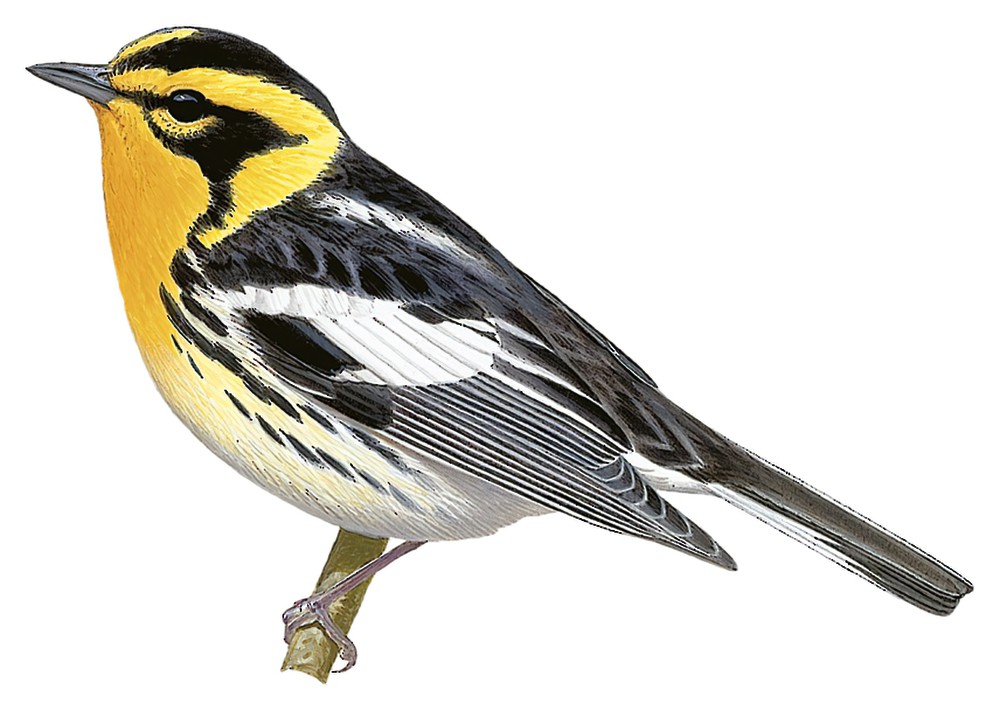Blackburnian Warbler / Setophaga fusca

Blackburnian Warbler
SCI Name:
Protonym: Motacilla fusca Natursyst.Suppl. Suppl. p.175
Taxonomy: Passeriformes / Parulidae / Setophaga
Taxonomy Code: bkbwar
Type Locality: Guyane [= French Guiana, fide Hellmayr, 1935, Field Mus. Nat. Hist. Publ., Zool. Ser., 13, pt. 8, p. 397].
Author: Statius Muller
Publish Year: 1776
IUCN Status: Least Concern
DEFINITIONS
SETOPHAGA
(Parulidae; Ϯ American Redstart S. ruticilla) Gr. σης sēs, σητος sētos moth; -φαγος -phagos -eating < φαγειν phagein to eat; "G. SETOPHAGA. Sw. in Zool. Journ. No. 10. 17. Setophaga ruticilla. Muscicapa ruticilla, Lin. mas. M. flavicaudæ. Gm. fem. Maritime parts. 18. Setophaga miniata. Cinereous, breast and body beneath vermilion; tail black, the lateral tail feathers partly white. Table land: woods of Valadolid; rare, size of the last. 19. Setophaga rubra. Entirely red, ear feathers of a silky whiteness. Inhabits the same woods, and is of the same size as the last." (Swainson 1827 (May)); "SETOPHAGA. Rostrum parvum; culmine carinato. Alæ mediocres; remigibus 1ma et 4ta æqualibus, 2da et 3tia æqualibus, longissimis. Cauda sub-elongata, rotundata. Pedes graciles, tarsis squamis anterioribus divisis, lateralibus integris. ... Type. Muscicapa ruticilla. Linn. ... It represents, in the new world, the Australian genus Rhipidura" (Swainson 1827 (July)); "Setophaga Swainson, 1827 (May), Philos. Mag., new ser., 1, fasc. 5, p. 368. Type, by subsequent designation (Swainson, 1827 (July), Zool. Journ., 3, p. 360), Motacilla ruticilla Linnaeus." (Lowery & Monroe in Peters 1968, XIV, 33). Doubtless time will soften the dismay of birdwatchers caused by the absorption of Dendroica, Parula and Wilsonia into Setophaga.
Var. Cetophaga.
Synon. Agreocantor, Azuria, Caeruleocantor, Chloris, Chrysocantor, Compsothlypis, Dendroica, Fruticantor, Lineocantor, Maculocantor, Myioctonus, Myiodioctes, Neodendroica, Parula, Perissoglossa, Piceacantor, Pinacantor, Ruticilla, Sylvania, Sylvicola, Sylviocantor, Sylviparus, Terracantor, Vireocantor, Wilsonia.
fusca
L. fuscus dusky, black, brown. Despite its classical meaning this epithet is used in ornithology to indicate a very wide spectrum of colours from black, grey and brown to a range of dark tints including slate-blue and dusky-orange (see also fuscus).
● ex “Héron brun de Cayenne” (= ☼) of d’Aubenton 1765-1781, pl. 858, and “Héron brun” of de Buffon 1770-1786 (syn. Agamia agami).
● ex “Gobe-mouche brun de la Martinique” of d’Aubenton 1765-1781, pl. 568, fig. 2 (Allenia).
● ex “Brown Sandpiper” of Pennant 1768, and Latham 1787 (syn. Calidris minuta).
● ex “Brown Tern” of Latham 1785 (syn. Chlidonias niger).
● ex “Promérops de la nouvelle Guinée” of d’Aubenton 1765-1781, pl. 638, “Promérops brun à ventre rayé” of de Buffon 1770-1783, “Promérops brun de la nouvelle Guinée” of Sonnerat 1776, and “New Guinea brown Promerops” of Latham 1782 (syn. Epimachus fastuosus).
● ex “White-breasted Barbet” of Latham 1782 (Malacoptila).
● "61. ANAS. ... fusca. 5. A. nigricans, macula pone oculos lineaque alarum albis. Anas corpore obscuro, macula alba pone oculos, lineaque alba. Fn. svec. 106. It. gotl. 215. 271. Anas fera fusca. Jonst. av. t. 44. Anas niger. Will. orn. 278. t. 10. Raj. av. 141. Habitat in oceano Europæo. Mas ad basin rostri gibbositate notatus." (Linnaeus 1758) (Melanitta).
● ex “Martin-pêcheur de la Nouvelle Guinée” of d’Aubenton 1765-1781, pl. 663 (= ♀), and “Great Brown Kingsfisher” of Latham 1782 (syn. Melidora macrorrhina).
● ex “Tangara brun d’Amérique” of d’Aubenton 1765-1781, pl. 155, fig. 2 (syn. Paroaria gularis).
● ex “Coot-footed Tringa” of Edwards 1743-1751, “Phalaropus fuscus” of Brisson 1760, and “Brown Phalarope” of Pennant 1785, and Latham 1785 (syn. Phalaropus lobatus).
● ex “Brown Creeper from the South Seas” of Latham 1782 (syn. Phylidonyris undulata).
● ex “Golondrina parda” of de Azara 1802-1805, no. 301 (subsp. Progne tapera).
● ex "Figuier étranger" of d'Aubenton 1765-1781, pl. 58, fig. 3 (Setophaga).
● ex “Bouveron” of de Buffon 1770-1783: “J’appelle ainsi cet oiseau ... parce qu’il me paroît faire la nuance entre les bouvreuils [bullfinches] d’Europe et les bec-ronds [seedeaters] d’Amérique” (syn. Sporophila lineola).
● ex “Barge brune” of d’Aubenton 1765-1781, pl. 875 (syn. Tringa erythropus).
● ex “Rasle brun des Philippines” of Brisson 1760 (Zapornia).
● ex “Tourterelle de la Caroline” of d’Aubenton 1765-1781, pl. 175 (syn. Zenaida macroura carolinensis).
● "96. LOXIA. ... fusca. 25. L. fusca, subtus albida, remigibus a tertia ad nonam basi omnino albis. Chin. Lagerstr. 19. Habitat in Benghala." (Linnaeus 1758) (unident.).
● ex “Figuier brun-olive” of de Buffon 1770-1783, and “Olive-brown Warbler” of Latham 1783, and Pennant 1785 (unident.).
● ex “Gobe-mouche brun de Cayenne” of d’Aubenton 1765-1781, pl. 574, fig. 1 (unident.; has been linked with Cnemotriccus fuscatus and with Contopus cinereus).
UPPERCASE: current genus
Uppercase first letter: generic synonym
● and ● See: generic homonyms
lowercase: species and subspecies
●: early names, variants, mispellings
‡: extinct
†: type species
Gr.: ancient Greek
L.: Latin
<: derived from
syn: synonym of
/: separates historical and modern geographic names
ex: based on
TL: type locality
OD: original diagnosis (genus) or original description (species)












